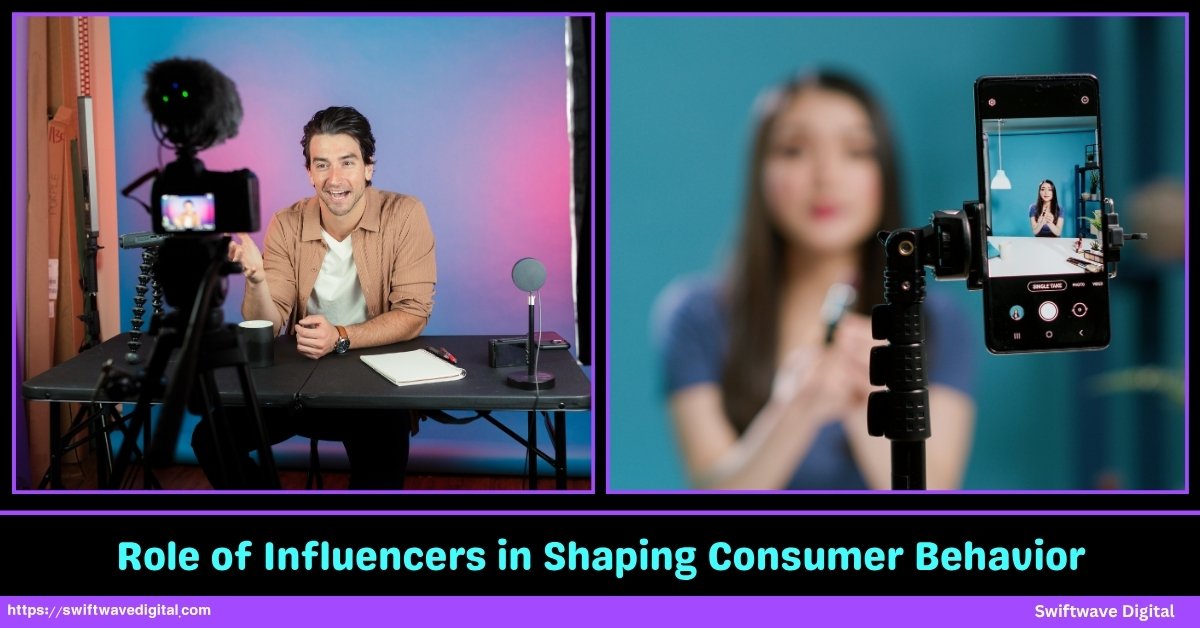Influencers have redefined how people make buying decisions in the digital era. With audiences spending hours daily on social media, the opinions, reviews, and lifestyles shared by influencers directly shape what consumers trust, desire, and purchase.
Unlike traditional advertisements that simply promote, influencers demonstrate showing real experiences that build credibility and emotional connection.
Whether it’s a skincare routine, tech gadget review, or travel recommendation, people now rely on influencer insights more than corporate messaging.
Studies show that modern consumers value authenticity and relatability over polished brand content, making influencers one of the most powerful forces in marketing today.
Role of Influencers in Shaping Consumer Behavior
In this guide, we will explain how Influencers shape consumer behavior, why their impact continues to grow, and what businesses can learn to adapt effectively.

1. Trust Over Traditional Advertising
In today’s Digital Marketplace, trust has become the most valuable marketing currency. Traditional advertising once relied on repetition and exposure — the more a consumer saw a product, the more likely they were to buy it. But that dynamic has shifted.
People no longer respond to generic brand messages; they seek opinions from real individuals they believe in. Influencers bridge that trust gap. They connect brands to audiences through personal experience rather than polished slogans.
According to Nielsen research, more than 90% of consumers trust recommendations from individuals over brand advertisements. This trust forms the foundation of influencer marketing.
When a familiar face or a relatable person shares their genuine opinion about a product, it feels like advice, not promotion.
Unlike TV or billboard ads, influencer recommendations feel personal, creating stronger recall and more confident purchase decisions.
2. The Psychology Behind Influence
Influencer marketing works because it aligns with basic human psychology. People are naturally social learners we observe, imitate, and adopt behaviors from others we admire or relate to.
This behavior is driven by three key psychological triggers: social proof, relatability, and emotional connection. Social proof makes people feel validated when they follow what others are doing, especially those they perceive as credible.
Relatability builds when influencers share real-life experiences, creating the sense that they understand their audience’s challenges and goals.
Emotional connection comes from consistency and trust built over time through authentic interactions. These elements make influencer content more persuasive than traditional ads because it feels organic.
Consumers subconsciously associate the influencer’s satisfaction with the product’s reliability. This human-centered influence is what drives action — not just awareness.
3. Micro-Influencers: The Real Game Changers
While large influencers attract visibility, micro-influencers drive results. Micro-influencers, typically with 10,000 to 100,000 followers, focus on niche topics and maintain stronger personal engagement with their audiences.
Their smaller communities are built on authenticity and frequent interaction, which translates into higher engagement rates and conversion potential.
Many consumers view micro-influencers as friends rather than celebrities, leading to genuine trust in their recommendations.
Because micro-influencers cater to specific interests such as fitness, tech gadgets, parenting, or skincare their followers tend to be more loyal and targeted.
This means brands can reach a precise audience that actually cares about their product category.
From a cost perspective, collaborating with multiple micro-influencers often provides better returns than one high-profile influencer campaign. The effectiveness of micro-influencers lies in depth of connection, not just reach.
4. Data-Driven Influence: Beyond Likes and Comments
Modern influencer marketing isn’t based on vanity metrics like follower counts or likes. It’s powered by data. Brands now analyze engagement rates, audience demographics, click-through rates, and conversion metrics to measure real impact.
This approach ensures that influencer partnerships are strategic and measurable. Tools and analytics platforms help identify which influencers align best with brand goals and which audiences are genuinely engaging.
Data also filters out fake followers and inflated metrics, protecting brands from wasted investments. By tracking metrics such as link clicks or product purchases tied to influencer campaigns, marketers can clearly see ROI.
This data-driven focus transforms influencer marketing from guesswork into performance-based marketing. The goal is no longer to just create buzz — it’s to generate measurable business outcomes like leads, sales, and long-term brand loyalty.
5. The Shift in the Buying Journey
Influencers have reshaped the traditional customer journey. Before, consumers would become aware of a product through advertising, compare options, then make a decision.
Now, influencers shorten this process dramatically. When a trusted influencer shares a product experience, it immediately influences awareness, consideration, and even purchase in one go.
The influencer’s authority eliminates much of the hesitation consumers once had, making decisions faster. This new journey is emotional rather than linear people buy not just because a product solves a problem, but because someone they trust validated it.
Social platforms have also integrated shopping features that allow instant purchases directly from influencer posts. This has blurred the line between content and commerce, making the influencer’s voice a critical part of the modern sales funnel.
Brands that understand this dynamic can optimize campaigns for direct action rather than passive exposure.
6. Authenticity: The Currency of Influence
In the influencer space, authenticity is everything. Audiences can easily detect insincerity or scripted endorsements. When an influencer’s content feels overly promotional, followers lose trust quickly.
True influence comes from honesty and consistency. Influencers who genuinely use the products they promote create lasting credibility.
Authentic storytelling sharing both positives and limitations helps audiences believe in the influencer’s judgment. Transparency, such as clearly marking sponsored posts or sharing behind-the-scenes experiences, further strengthens this trust.
Consumers today are not against sponsored content; they just expect honesty. According to research, audiences engage more with influencers who are open about their partnerships.
This transparency reinforces integrity, helping influencers build a loyal following over time. Brands should prioritize working with influencers who align naturally with their values rather than chasing those with the largest audiences.
7. Influencer Marketing Across Industries
Influencer marketing is not limited to lifestyle, beauty, or fashion anymore. Every industry from technology to finance to healthcare has embraced influencer collaboration.
In tech, influencers provide practical product reviews that help users make informed choices. In food and beverage, influencers showcase recipes, taste tests, and lifestyle integration, boosting brand awareness and trust.
Travel influencers inspire destination choices by sharing authentic experiences. Even serious sectors like finance and health use credible influencers to simplify complex topics for the general public.
This cross-industry adaptability shows the strength of influencer marketing in connecting specialized audiences to relevant products. Businesses that understand their audience’s needs can find influencers who communicate those needs in relatable ways.
The key is fit — not fame. When influencers and industries align naturally, campaigns feel genuine, leading to stronger engagement and consumer response.
8. Challenges in the Influencer Space
Despite its effectiveness, influencer marketing faces real challenges. One major issue is fake engagement influencers with inflated followers or purchased likes can mislead brands about their true reach.
This creates distrust and reduces ROI. Another challenge is content saturation; audiences are exposed to hundreds of promotions daily, making it harder for brands to stand out.
Maintaining authenticity amid constant sponsorships is also a growing concern. Over-commercialization can damage an influencer’s credibility, leading to reduced audience trust.
Moreover, regulatory compliance has become critical. Many countries now require influencers to disclose paid partnerships to ensure transparency.
Brands and influencers must adapt to these changes by maintaining honesty, using analytics to verify authenticity, and prioritizing long-term collaborations instead of one-time promotions.
Addressing these challenges is essential to sustaining influencer marketing as a credible and effective strategy.
9. Future Trends: Where It’s Headed
The future of influencer marketing is moving toward precision, accountability, and authenticity. Artificial intelligence will play a larger role in identifying the right influencers and predicting campaign performance.
Brands will increasingly adopt performance-based contracts, rewarding influencers based on measurable outcomes like sales or conversions rather than post reach.
Nano-influencers those with under 10,000 followers will gain more importance for their close-knit audience relationships. Another emerging trend is the rise of virtual influencers computer-generated personalities that brands can control entirely, providing consistency and creative flexibility.
However, human connection will remain irreplaceable, as audiences value real stories and emotions. Social platforms will continue refining shopping features to make influencer content more transactional, blurring the gap between entertainment and commerce.
The next phase of influencer marketing will be data-driven, transparent, and deeply personalized, making authentic storytelling more powerful than ever.
Conclusion
Influencers have become a defining force in modern marketing, reshaping how consumers discover, evaluate, and purchase products.
Their ability to build trust, share authentic experiences, and connect emotionally with audiences has made them far more effective than traditional advertising methods.
Consumers today don’t just buy products; they buy the confidence and validation influencers provide.
As digital platforms continue to evolve, the relationship between influencers and brands will grow stronger, driven by transparency, performance tracking, and genuine storytelling.
Businesses that understand the power of this relationship will stay ahead, creating marketing strategies that not only reach audiences but also influence their decisions meaningfully.
In the end, influencers aren’t replacing advertising — they’re redefining it for a new era of consumer trust and connection.



